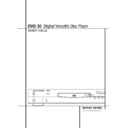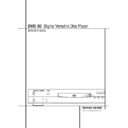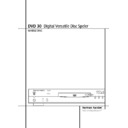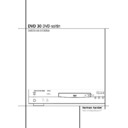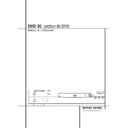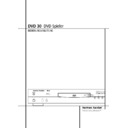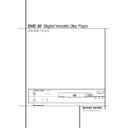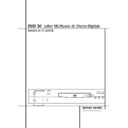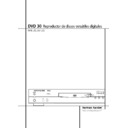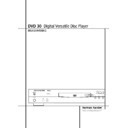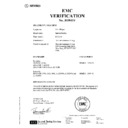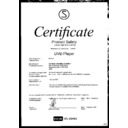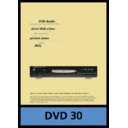Harman Kardon DVD 30 (serv.man6) User Manual / Operation Manual ▷ View online
DVD 30 Digital Versatile Disc Player
OWNER’S MANUAL
Power for the Digital Revolution™
®
2 TABLE OF CONTENTS
3
Introduction
4
Terminology
5
Features, Packing List
6
Front Panel Controls
7
Front Panel Information Display
8
Remote Control
10
Rear Panel Connections
11
Setup and Connections
11
to a Stereo TV and Stereo or Pro Logic
Amplifier/Receiver
Amplifier/Receiver
12
to a Dolby Digital/DTS Amplifier/Receiver
13
to a TV or monitor with SCART or
Component Connectors
Component Connectors
14
Remote Control
15
Digital Audio Connections
16
Playback Basics
16
Basic Play
16
Playback Features
16
System Set-up
17
System Defaults
17
Set-up Menu
17
Navigating Menus
17
Video Menu
17
Video Output
17
SCART Video
17
Scan Type
18
TV Standard
19
Aspect Ratio
19
Audio Menu
19
Dynamic Range
19
Audio Language
19
Select Other Audio Language
19
Digital Output
19
PCM Limit
20
Speaker Setup Menu
21
Output Level Adjustment
22
Delay Settings
22
Player Set-Up Menu
22
Parental Control
22
Password
23
Display Language
23
Menu Language
23
Subtitle Language
23
Status Bar Timeout
23
Panel Dimmer
24
Test Screen
24
Test Screen
24
TV Picture Adjustment with Test Screen
24
Playing DVD-AUDIO/VIDEO Discs
25
Using the Status Bar
25
Selecting a Title/Chapter
25
Using Bookmarks
25
Changing Audio Track
26
Changing Subtitle Language
26
Changing Camera Angle
26
Repeat Play
26
Zoom Playback
26
Information Menus
27
Programmed Play with DVD
28
CD Playback
28
Disc Compatibility
28
To Load and Play an Audio CD
28
Audio CD Playback Features
28
Using the Status Bar
28
Information Menus
28
Selecting a Track
28
Using Bookmarks
29
Selecting the Time Display
29
Repeat Play
29
Random Play
Table of Contents
2
NOTE: This player is designed and manufac-
tured for compatibility with Region
Management Information that is encoded on
most DVD discs. This player is designed only for
tured for compatibility with Region
Management Information that is encoded on
most DVD discs. This player is designed only for
playback of discs with Region Code 2, or for
discs that do not contain Region Code infor-
mation. If there is any other Region Code on a
disc, that disc will not play on the DVD 30.
discs that do not contain Region Code infor-
mation. If there is any other Region Code on a
disc, that disc will not play on the DVD 30.
Declaration of Conformity
We, Harman Consumer International
2, Route de Tours
72500 Château-du-Loir,
FRANCE
72500 Château-du-Loir,
FRANCE
declare in own responsibility, that the product described in
this owner’s manual is in compliance with technical
standards:
this owner’s manual is in compliance with technical
standards:
EN 60 065:1993
EN 55 013/A12/8.1994
EN 55 020/12.1994
EN 61000-3-2/4.1995
EN 61000-3-3/1.1995
Carsten Olesen
Harman Kardon Europe
02/03
30
Programmed Play with CD
31
MP3/WMA Playback
32
VCD Playback
33
Troubleshooting Guide
34
DVD Language Codes
35
Specifications
INTRODUCTION 3
Introduction
Thank you for choosing the Harman
Kardon DVD 30. The DVD 30 is a multipurpose
DVD player, capable of playing both DVD-Audio
and DVD-Video discs and conventional CD audio
discs with the highest fidelity and access to
future software upgrades via the Internet. Along
with conventional DVD-Audio/Video and CD
audio discs, the DVD 30 is also compatible with
MP3, CD-R and CD-RW as well as VCD discs.
Kardon DVD 30. The DVD 30 is a multipurpose
DVD player, capable of playing both DVD-Audio
and DVD-Video discs and conventional CD audio
discs with the highest fidelity and access to
future software upgrades via the Internet. Along
with conventional DVD-Audio/Video and CD
audio discs, the DVD 30 is also compatible with
MP3, CD-R and CD-RW as well as VCD discs.
To enable you to get the maximum quality from
DVDs, the DVD 30 is equipped with the latest in
design techniques, including advanced 10-bit
video digital-to-analog converters (DAC) and
Video (composite), S-Video and RGB video (RGB
via SCART) outputs, to ensure that you get all the
quality inherent in today’s DVD medium. For opti-
mum playback of NTSC and PAL DVD with com-
patible high-definition display devices, DVD 30 is
equipped with progressive component video out-
puts.
DVDs, the DVD 30 is equipped with the latest in
design techniques, including advanced 10-bit
video digital-to-analog converters (DAC) and
Video (composite), S-Video and RGB video (RGB
via SCART) outputs, to ensure that you get all the
quality inherent in today’s DVD medium. For opti-
mum playback of NTSC and PAL DVD with com-
patible high-definition display devices, DVD 30 is
equipped with progressive component video out-
puts.
In addition, Harman Kardon’s audio heritage
continues into the digital video era with audio-
phile-grade Wolfson DACs to ensure that the
audio quality matches the superb video. Of
course, both coaxial and optical digital audio
outputs are available for direct connection to A/V
receivers or processors so that you may take
advantage of Dolby Digital* and DTS
continues into the digital video era with audio-
phile-grade Wolfson DACs to ensure that the
audio quality matches the superb video. Of
course, both coaxial and optical digital audio
outputs are available for direct connection to A/V
receivers or processors so that you may take
advantage of Dolby Digital* and DTS
®
sound-
tracks. When playing audio CDs, the playback
quality is state-of-the-art, matching that of the
finest players available.
quality is state-of-the-art, matching that of the
finest players available.
A wide range of programming features makes it
easy to program an evening’s worth of entertain-
ment. When playing DVDs, easy-to-understand
on-screen menus and icons make it simple to
change languages, soundtracks, subtitles or
aspect ratio, while a parental-lock function
enables you to control which discs may be
viewed by younger members of the household.
easy to program an evening’s worth of entertain-
ment. When playing DVDs, easy-to-understand
on-screen menus and icons make it simple to
change languages, soundtracks, subtitles or
aspect ratio, while a parental-lock function
enables you to control which discs may be
viewed by younger members of the household.
DVD players are among the fastest growing con-
sumer electronics products ever brought to mar-
ket, but this may, nevertheless, be the first DVD
player you’ve owned. Although many of the fea-
tures of the DVD 30 resemble those of standard
CD players, there are a number of functions that
you may be unfamiliar with. To ensure that you
are able to take advantage of all the power and
flexibility the DVD 30 has to offer, we encourage
you to review this manual. That small investment
of your time will pay major dividends in the
enjoyment you will get from proper use of the
DVD 30.
sumer electronics products ever brought to mar-
ket, but this may, nevertheless, be the first DVD
player you’ve owned. Although many of the fea-
tures of the DVD 30 resemble those of standard
CD players, there are a number of functions that
you may be unfamiliar with. To ensure that you
are able to take advantage of all the power and
flexibility the DVD 30 has to offer, we encourage
you to review this manual. That small investment
of your time will pay major dividends in the
enjoyment you will get from proper use of the
DVD 30.
If you have additional questions about this
product or its installation or operation that are
not answered in this manual, please contact your
dealer, as he is your best source of local informa-
tion.
product or its installation or operation that are
not answered in this manual, please contact your
dealer, as he is your best source of local informa-
tion.
■ Plays a Wide Range of Video and Audio
Formats, Including DVD-Movie Discs,
VCD, Standard CD Audio Discs, CD-R/RW
Audio Discs and MP3 Discs
VCD, Standard CD Audio Discs, CD-R/RW
Audio Discs and MP3 Discs
■ DVD-Audio Playback for Richer Detail,
Expanded Dynamic Range and Improved
Realism
Realism
■ 6-Channel Direct Output for DVD-Audio
■ Extensive Bass Management Options for
■ Extensive Bass Management Options for
DVD-Audio with Speaker Setup, Output
Level Adjustment and Delay Settings
Level Adjustment and Delay Settings
■ High-Quality Video Playback 10-Bit
DACs, Progressive Scan and Component
Video Outputs
Video Outputs
■ Dolby Digital and DTS Data Signal
Output Through Both Optical and
Coaxial Digital Audio Connections
Coaxial Digital Audio Connections
■ Audiophile-Grade Wolfson Output DACs
for the Finest Audio reproduction
■ Easy-to-Use On-Screen Navigation
System
■ Playback of MP3 and Windows(r) WMA
Audio Discs and JPEG image files
■ Extensive Programming Capability for
Audio and Video Discs
■ Parental Lock Controls Prevent
Unauthorized Viewing of Restricted
Movies
Movies
■ Multiple Options for Language,
Soundtrack and Subtitle Selection
■ Multiple-Angle Capabilities With
Specially Encoded DVD Discs
■ Backlit, Ergonomically Designed Remote
Control
4 TERMINOLOGY
Terminology
Since they share some of the characteristics and
technology of CD players, many of the terms and
operational concepts used in a DVD player are
similar to what you may be familiar with from CD
players and changers, or older video disc formats
such as Laser Disc. However, if this is your first
DVD product, some of the terms used to describe
the features of a DVD player may be unfamiliar.
The following explanations should solve some of
the mysteries of DVD, and help you to enjoy all
the power and flexibility of the DVD format and
the DVD 30.
technology of CD players, many of the terms and
operational concepts used in a DVD player are
similar to what you may be familiar with from CD
players and changers, or older video disc formats
such as Laser Disc. However, if this is your first
DVD product, some of the terms used to describe
the features of a DVD player may be unfamiliar.
The following explanations should solve some of
the mysteries of DVD, and help you to enjoy all
the power and flexibility of the DVD format and
the DVD 30.
With the arrival of DVD, disc data capacity has
increased dramatically. On a DVD Video disc most
of this capacity is taken up by MPEG 2 video and
the multichannel movie soundtrack in Dolby
Digital and/or DTS. This information is com-
pressed. But with DVD Audio, most of this capaci-
ty is available for music only, without any com-
pression. This allows us to put the audio informa-
tion on the disc in the same quality as the origi-
nal mastering in the studio, in PCM up to 24
bit/192 kHz.
increased dramatically. On a DVD Video disc most
of this capacity is taken up by MPEG 2 video and
the multichannel movie soundtrack in Dolby
Digital and/or DTS. This information is com-
pressed. But with DVD Audio, most of this capaci-
ty is available for music only, without any com-
pression. This allows us to put the audio informa-
tion on the disc in the same quality as the origi-
nal mastering in the studio, in PCM up to 24
bit/192 kHz.
DVD-Audio's 24-bit system provides substantially
improved resolution of fine detail, because it
describes a specific point in the musical informa-
tion using a 24-digit long string of one's and
zero's with 16,777,216 possible combinations,
while CD's primitive 16-bit system offers only
65,536 options. The 192 kHz frequency allows us
to have fast changes in music made audible,
which results in more dynamism, and also allows
us to obtain a higher bandwidth, up to 96 kHz.
Although that is far beyond the human audible
spectrum, it still improves the musical realism.
improved resolution of fine detail, because it
describes a specific point in the musical informa-
tion using a 24-digit long string of one's and
zero's with 16,777,216 possible combinations,
while CD's primitive 16-bit system offers only
65,536 options. The 192 kHz frequency allows us
to have fast changes in music made audible,
which results in more dynamism, and also allows
us to obtain a higher bandwidth, up to 96 kHz.
Although that is far beyond the human audible
spectrum, it still improves the musical realism.
Aspect Ratio: This is a description of the width
of a video image in relation to its height. A con-
ventional video screen is four units wide for every
three units of height, that’s why the ratio is called
”4:3”. Newer wide aspect ratio video displays
are 16 units wide for every nine units of height,
making them more like the screen in a movie the-
ater. The program material on a DVD may be
recorded in either format and, in addition, you
may configure the DVD 30 to play back in either
format, depending on the features recorded on a
disc. (For details about TV Aspect Ratio see page
18).
of a video image in relation to its height. A con-
ventional video screen is four units wide for every
three units of height, that’s why the ratio is called
”4:3”. Newer wide aspect ratio video displays
are 16 units wide for every nine units of height,
making them more like the screen in a movie the-
ater. The program material on a DVD may be
recorded in either format and, in addition, you
may configure the DVD 30 to play back in either
format, depending on the features recorded on a
disc. (For details about TV Aspect Ratio see page
18).
Title: For a DVD, a title is defined as an entire
movie or program. There can be as many chapters
within a title as the producers decide to include.
Most discs include only one title, but some may
have more than one, to give you a “Double
Feature” presentation. Press the MENU button on
the remote to see the Menu of the DVD where you
can find all titles available on the DVD or all chap-
ters, if the disc has only one title.
movie or program. There can be as many chapters
within a title as the producers decide to include.
Most discs include only one title, but some may
have more than one, to give you a “Double
Feature” presentation. Press the MENU button on
the remote to see the Menu of the DVD where you
can find all titles available on the DVD or all chap-
ters, if the disc has only one title.
Chapter: DVD programs are divided into chap-
ters and titles. Chapters are the sub-sections pro-
grammed into a single title on a disc. Chapters
may be compared to the individual tracks on an
audio CD.
ters and titles. Chapters are the sub-sections pro-
grammed into a single title on a disc. Chapters
may be compared to the individual tracks on an
audio CD.
RGB Video: This is a new form of video signal
that eliminates many of the artifacts of traditional
composite video signals by splitting the signal
into the three fundamental colors Red, Green and
Blue (RGB). With an RGB connection (via SCART),
you will see greater picture resolution and elimi-
nate many picture imperfections such as the
moiré patterns often seen on checkered pat-
terned cloths. However, in order to benefit from
RGB video, you must have a video display with an
RGB compatible SCART input.
that eliminates many of the artifacts of traditional
composite video signals by splitting the signal
into the three fundamental colors Red, Green and
Blue (RGB). With an RGB connection (via SCART),
you will see greater picture resolution and elimi-
nate many picture imperfections such as the
moiré patterns often seen on checkered pat-
terned cloths. However, in order to benefit from
RGB video, you must have a video display with an
RGB compatible SCART input.
Progressive scan: DVD 30 offers progressive
scan video outputs for use with compatible high-
resolution televisions and projectors. Before DVD,
no consumer medium could store, transmit or dis-
play video with full resolution. To conserve band-
width, analog compression (interlacing) is
employed: first the odd-numbered lines of a frame
are displayed, followed by the even-numbered
lines. The result is that only half of the video
image is drawn at one time; the viewer's brain
must reassemble the complete image. This is
acceptable, if the monitor is not too large and if
there is not too much motion in the image. Large
displays and fast-moving images reveal the limita-
tions of this system. Thanks to DVD's immense
data capacity, images are now stored intact (pro-
gressively), so that all the lines in each frame (odd
and even) are shown at the same time. But
because most TV's cannot handle a progressive
signal, all current DVD players generate an inter-
laced output for compatibility. Now, Harman
Kardon DVD 30 is among the select few DVD
players with true progressive scan video output
(NTSC and PAL) for use with compatible TV's and
CRT projectors and with all plasma, LCD and DLP
display devices via the component video output.
The result is 40% greater light output than a con-
ventional TV and a stunningly detailed high defini-
tion image, along with an almost complete
absence of visible scanlines and motion artifacts.
Of course, traditional Y/Pr/Pb component video,
SCART, S-Video and composite video outputs are
included for use with conventional televisions and
projectors.
scan video outputs for use with compatible high-
resolution televisions and projectors. Before DVD,
no consumer medium could store, transmit or dis-
play video with full resolution. To conserve band-
width, analog compression (interlacing) is
employed: first the odd-numbered lines of a frame
are displayed, followed by the even-numbered
lines. The result is that only half of the video
image is drawn at one time; the viewer's brain
must reassemble the complete image. This is
acceptable, if the monitor is not too large and if
there is not too much motion in the image. Large
displays and fast-moving images reveal the limita-
tions of this system. Thanks to DVD's immense
data capacity, images are now stored intact (pro-
gressively), so that all the lines in each frame (odd
and even) are shown at the same time. But
because most TV's cannot handle a progressive
signal, all current DVD players generate an inter-
laced output for compatibility. Now, Harman
Kardon DVD 30 is among the select few DVD
players with true progressive scan video output
(NTSC and PAL) for use with compatible TV's and
CRT projectors and with all plasma, LCD and DLP
display devices via the component video output.
The result is 40% greater light output than a con-
ventional TV and a stunningly detailed high defini-
tion image, along with an almost complete
absence of visible scanlines and motion artifacts.
Of course, traditional Y/Pr/Pb component video,
SCART, S-Video and composite video outputs are
included for use with conventional televisions and
projectors.
Multiple Angle: DVDs have the capability to
show up to four different views of the same
scene in a program. When a disc is encoded with
multiple-angle information, pressing the Angle
button will enable you to switch between these
different views. Note that at present, few discs
take advantage of this capability and, when they
do, the multiple-angle technology may only be
present for short periods of time within the disc.
Producers will usually insert some sort of icon or
graphic in the picture to alert you to the availabil-
ity of multiple viewing angles.
show up to four different views of the same
scene in a program. When a disc is encoded with
multiple-angle information, pressing the Angle
button will enable you to switch between these
different views. Note that at present, few discs
take advantage of this capability and, when they
do, the multiple-angle technology may only be
present for short periods of time within the disc.
Producers will usually insert some sort of icon or
graphic in the picture to alert you to the availabil-
ity of multiple viewing angles.
Reading: This is a message that you will see
after you´ve loaded the disc and the tray has
closed. It refers to the fact that the player must
first examine the contents of the disc to see if it is
a CD or DVD, and then extract the information
about the type of material on the disc, such as
languages, aspect ratios, subtitles, number of
titles and more. The slight delay while the con-
tents of the disc are read is normal.
after you´ve loaded the disc and the tray has
closed. It refers to the fact that the player must
first examine the contents of the disc to see if it is
a CD or DVD, and then extract the information
about the type of material on the disc, such as
languages, aspect ratios, subtitles, number of
titles and more. The slight delay while the con-
tents of the disc are read is normal.
Resume: The operation of the Stop Button on
the DVD 30 works differently from what you are
used to on CD players. On a traditional CD player,
when you press the Stop button, the unit does
just that: it stops playback. On a CD player, when
you press the start button again, the disc starts
from the beginning. With the DVD 30, however,
you have two options when playing DVD discs.
Pressing Stop once will stop playback, but it actu-
ally puts the unit in the Resume mode. This
means that you can turn the machine off and,
when you press play the next time, the disc will
resume or continue from the point on the disc
where the Stop button was pressed. This is help-
ful if you are watching a movie and must inter-
rupt your viewing session but wish to pick up
where you left off. Pressing the Stop button twice
will stop the machine in a traditional manner
and, when the disc is played again, it will start
from the beginning.
the DVD 30 works differently from what you are
used to on CD players. On a traditional CD player,
when you press the Stop button, the unit does
just that: it stops playback. On a CD player, when
you press the start button again, the disc starts
from the beginning. With the DVD 30, however,
you have two options when playing DVD discs.
Pressing Stop once will stop playback, but it actu-
ally puts the unit in the Resume mode. This
means that you can turn the machine off and,
when you press play the next time, the disc will
resume or continue from the point on the disc
where the Stop button was pressed. This is help-
ful if you are watching a movie and must inter-
rupt your viewing session but wish to pick up
where you left off. Pressing the Stop button twice
will stop the machine in a traditional manner
and, when the disc is played again, it will start
from the beginning.
In resume mode, the cover of the DVD will be
displayed, if available. Otherwise, the
Harman Kardon screen will appear.
displayed, if available. Otherwise, the
Harman Kardon screen will appear.
Terminology

